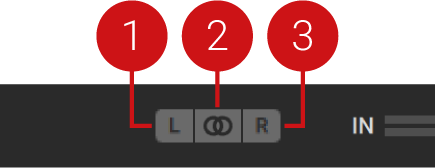Signal Flow
GUITAR RIG is a modular effects processor based on the Rack, where you stack effects on top of each other. The signals are passed in the Rack from top to bottom.
GUITAR RIG is a modular effects processor that combines individual effects, called Components, in an effects chain. This effects chain is hosted in the Rack, where you can stack Components on top of each other. The signals are passed in the Rack from top to bottom.
The inputs are sent to the first Component at the top, and the outputs are taken from the last Component at the bottom. The Rack's outputs are sent to the Global FX before being passed on to the final outputs of GUITAR RIG. For more information, refer to Global FX.
The Rack has a stereo input and a stereo output. In the stand-alone application, you can assign any of the inputs and outputs of your audio interface to the Rack's stereo input and output. In the plug-in, the inputs and outputs depend on where it is inserted in the DAW.
Tip
For more information about assigning inputs and outputs in the stand-alone application, refer to Setting up GUITAR RIG as Stand-Alone Application.
Input Selector
The Input selector in the Header enables you to select the input configuration for the Rack. The following options are available:
 |
Left Input: Only the left stereo input is used in a mono configuration. Components using stereo processing receive the signal from the left stereo input on both stereo channels.
Stereo Input: Both the left and right stereo input are used in a stereo configuration. Components using stereo processing receive the signals from the left and right stereo inputs on the respective stereo channel.
Note
When Stereo Input is selected, the Stereo option in the Component Controls is activated automatically for all relevant Components. For more information, refer to Component Controls.
Right Input: Only the left stereo input is used in a mono configuration. Components using stereo processing receive the signal from the right stereo input on both stereo channels.
Mono and Stereo Processing
Most Components use stereo processing from input to output, which means that generally stereo signals are preserved throughout the Rack. Certain Components provide an option in the Component Controls that switches between mono and stereo processing. You can use this to reduce the CPU load by deactivating stereo processing. For more information, refer to Component Controls.
However, there are also Components that always sum the left and right stereo inputs to mono. Nevertheless, their output can be stereo, depending on the the processing applied by the Component.
The following Components sum the stereo inputs to mono:
Cabinets & Mics (mono output)
Psyche Delay (stereo output)
Quad Delay (stereo output)
Flanger Chorus (stereo output)
Rotator (stereo output)
Stereo Tune (stereo output)
Octaverb (stereo output)
Little REFLEKTOR (stereo output)
RAUM (stereo output)
REFLEKTOR (stereo output)
TRAKTOR's Reverb (stereo output)